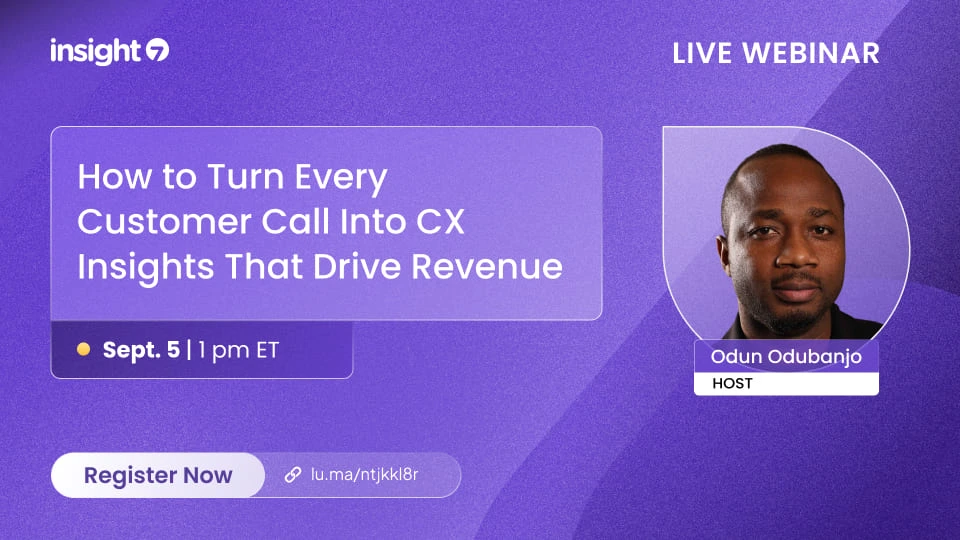Call Centre Voice Analytics: Ultimate Guide
-
Bella Williams
- 10 min read
Navigating the complexities of customer interactions is crucial for modern businesses. The potential of voice analytics in call centres transforms raw data into actionable insights, enabling teams to enhance customer experiences significantly. This Voice Analytics Guide serves as a foundational resource, helping you understand how to harness the power of voice technology in your operations.
In this guide, we will explore the key elements of call centre voice analytics. From understanding its role in enhancing communication to implementing effective analytical tools, every aspect is tailored to empower you. Embarking on this journey will not only improve efficiency but also refine your customer engagement strategies.
Generate visualizations from your qualitative data. At Scale.

What is Call Centre Voice Analytics?
Call centre voice analytics refers to the technology and methods used to analyze customer interactions through voice recordings. This innovative approach enables businesses to extract valuable insights from conversations, improving customer service and operational efficiency. By utilizing sophisticated algorithms and machine learning, voice analytics identifies patterns, trends, and sentiments expressed during calls.
In a world where customer experience is paramount, understanding voice analytics becomes essential. It helps organizations assess agent performance, detect compliance issues, and pinpoint customer sentiments. Ultimately, this technology empowers teams to make informed decisions, enhancing training programs and refining customer engagement strategies. With the right tools, businesses can effectively track customer needs and adapt their services, ensuring a proactive approach to customer satisfaction.
The Role of Voice Analytics Guide in Modern Call Centres
In modern call centres, the Voice Analytics Guide plays a crucial role in enhancing operational efficiency and customer understanding. By streamlining the analysis of call interactions, this guide allows managers to identify key trends and performance issues without the labor-intensive process of manual reviews. Automated evaluations of customer service representatives’ (CSRs) performance provide actionable insights, facilitating targeted training and development.
Moreover, this guide aids in recognizing frequently asked customer questions and preferences, informing teams about evolving client needs. By consolidating data on call outcomes and CSR compliance, it fosters a culture of continuous improvement. In essence, the Voice Analytics Guide empowers call centres to respond more effectively to customer inquiries and adapt their training programs based on real-time data, ultimately driving higher satisfaction and loyalty.
Essential Features of Voice Analytics Solutions
Voice analytics solutions offer critical functionalities that transform how call centers operate. The essential features of these solutions include real-time transcription, emotion detection, and comprehensive reporting capabilities. By providing accurate transcriptions of customer interactions, call centers can analyze conversations for compliance, quality, and training purposes. Emotion detection enhances understanding of customer sentiments, allowing agents to tailor their responses for better engagement.
Another vital aspect is the ability to generate actionable insights from data analysis. This includes identifying patterns and trends over time, which helps organizations refine strategies and improve customer service. Integrating these insights into coaching practices equips call center agents with the knowledge to excel in their roles. To maximize the benefits of voice analytics, ensure you select a solution that includes customizable dashboards and data security features. These elements are essential in cultivating a responsive and customer-centric call center environment.
Evaluate Performance on Customer Calls for Quality Assurance.
Implementing Voice Analytics: A Step-by-Step Voice Analytics Guide
Implementing voice analytics begins with a solid foundation, which involves preparing your data infrastructure. This first step is critical, as it ensures that you have the right systems to collect, store, and process audio data from customer interactions. Make sure your existing technology can handle the volume and complexity of calls you receive.
Next, selecting the right voice analytics software is essential for extracting actionable insights. When considering various options, look for features that facilitate easy transcription, intuitive analysis, and the ability to generate reports that meet your business needs. An effective voice analytics guide not only streamlines the process but also enhances customer experience by identifying trends and pain points.
By following these steps, you can integrate voice analytics into your call center operations, significantly improving performance and customer satisfaction over time.
Step 1: Preparing Your Data Infrastructure
A solid data infrastructure is the backbone of any effective voice analytics system. Start by assessing your existing data sources, including call recordings and customer interaction logs. This initial evaluation enables you to identify gaps in your data and prioritize which elements are essential for analysis. A comprehensive understanding of your data landscape sets the foundation for meaningful insights.
Next, consider the integration of various data streams. This may include aligning your voice data with CRM systems, employee databases, and customer feedback platforms. Not only will this create a holistic view of interactions, but it will also enable more robust analytics capabilities. Additionally, ensure your system supports data privacy regulations, as compliance is vital for maintaining customer trust and safeguarding sensitive information. By strategically preparing your data infrastructure, you can optimize your voice analytics guide and ensure meaningful results from your call centre operations.
Step 2: Choosing the Right Voice Analytics Software
Selecting the right voice analytics software is crucial to optimizing your call center operations. First, consider your specific business needs. Identify the features that are essential for your organization such as real-time transcription, sentiment analysis, or call scoring. Each of these features plays a pivotal role in enhancing agent performance and customer satisfaction.
Next, evaluate the integration capabilities of the software. Your chosen solution should seamlessly integrate with existing CRM systems and other tools you use. This connectivity ensures that you can access and analyze data efficiently. Lastly, consider the cost implications and vendor support services. A competitive price aligns with the features you require, while robust support can make the implementation easier. Making informed decisions during this selection process will empower your call center to gain valuable insights through voice analytics, which is essential for improving communication and service delivery.
Conclusion: The Future of Call Centre Voice Analytics Guide
As we conclude our exploration of the Voice Analytics Guide, it’s clear that this technology has substantial potential for the future of call centers. Voice analytics not only enhances customer experience but also enables teams to derive actionable insights from conversations at scale. By transcribing recordings and analyzing them, organizations can pinpoint customer pain points and improve service delivery effectively.
Looking ahead, the evolution of voice analytics will likely integrate more advanced AI capabilities. This progress will facilitate deeper insights and streamline the call analysis process further. Embracing this technology equips businesses to remain competitive while ensuring they meet evolving customer expectations. The journey into voice analytics is just beginning, paving the way for smarter operations and enhanced customer relationships.







